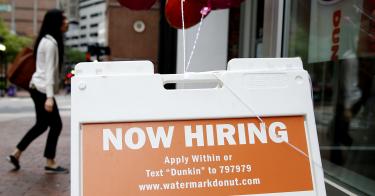Unemployment benefits are supposed to flow only to workers who have lost their jobs through no fault of their own, and employers are supposed to have to verify that workers lost their jobs.
Yet since the coronavirus pandemic, the number of unemployment checks going out has far exceeded the number of unemployed workers (176 checks for every 100 unemployed). And some policymakers want to enact further, permanent expansions in unemployment benefits.
The pandemic programs show us that’s precisely what not to do. Between April 2020 and May 2021, at least 557 million unemployment checks—an estimated $357 billion of taxpayers’ money—went to people who were not actually unemployed.
So how did this happen?
>>> 4 Reasons Why Federal Government Shouldn’t Permanently Expand Jobless Benefits
When the pandemic hit and tens of millions of people lost their jobs, Congress enacted massive expansions to the unemployment program. Lawmakers extended coverage to include people who do not participate or pay into the unemployment insurance program (such as the self-employed and gig-workers). They added a $600 bonus payment on top of normal benefits (later reduced to $300). They increased the number of weeks workers could claim benefits and allowed people to claim benefits for a wider range of reasons, such as quitting their job because of COVID-19 or having children affected by school and child-care closures.
These expansions were supposed to last for fewer than five months, yet most are now on track to remain, 18 months after the start of the pandemic.
All these changes required easing eligibility and verification criteria, meaning that instead of employers who participate in the unemployment system having to verify workers’ eligibility, individuals could simply self-report information necessary to claim benefits.
This effectively allowed criminals to steal Americans’ personal information and claim unemployment benefits with relative ease.
As the Department of Labor’s inspector general reported last month: “The unprecedented infusion of federal funds into the UI program gave individuals and organized criminal groups a high-value target to exploit. That, combined with easily attainable stolen personally identifiable information and continuing UI program weaknesses identified by … [this office] over the last several years, allowed criminals to defraud the system.”
In California—the state with the highest number of unemployment claims—the Employment Development Department sent out 38 million pieces of mail including residents’ Social Security numbers even after a March 2019 state auditor report recommended ending that practice.
California’s own EDD estimates that as many as one out of every four benefit checks it sent out was fraudulent, including 35,000 checks made out to the names of ineligible prison inmates.
In 2020, the Federal Trade Commission received nearly 400,000 identity-theft reports from individuals who said their personal information had been used to claim a government benefit—a 30-fold increase from the 13,000 such reports filed in 2019.
In addition to outright fraud and likely hundreds of billions of taxpayers’ dollars going to criminals, the expansion in benefits invited misuse and abuse, with anecdotal evidence of workers lying about their current income and work and falsifying how much income they were receiving prior to the pandemic.
And supersized benefits—with unemployment checks initially exceeding workers’ prior wages for two-thirds of unemployment recipients—have caused businesses to have to compete with the government to get the workers they need to recover.
>>> Excessive Pandemic Unemployment Benefits Are a Warning Against Unemployment Program Expansions
There are a record-high 9.2 million job openings in the U.S., and yet the unemployment rate remains high, at 5.9%. That’s 4.3 million more jobs than were available the last time that unemployment was at 5.9%.
Researchers consistently find that more generous unemployment insurance benefits lead to higher unemployment, which hurts workers and leads to a smaller economy.
Between massive fraud and worker shortages, expanded unemployment insurance benefits have arguably been the federal government’s most flawed—and damaging—economic policy enacted in response to COVID-19.
These systemic failures should serve as a red flag to policymakers thinking about turning temporary unemployment expansions into permanent new government programs.
This piece originally appeared in The Washington Times




